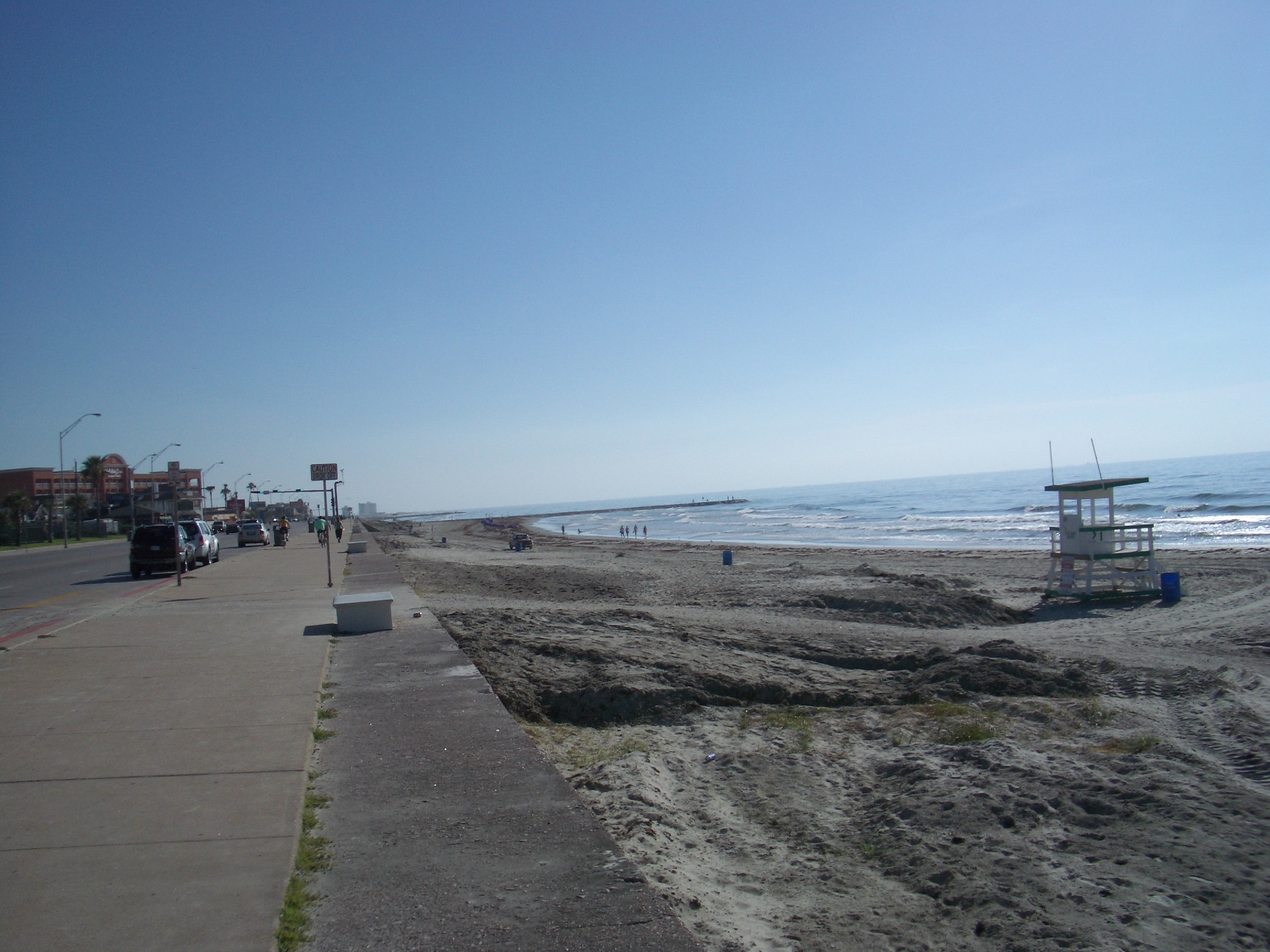
Main Page > 2005 Houston, We have a Problem !!
Another day is paradise was not what the boys were thinking the next morning as the Boys faced another 100 degree day, it reminded them of a realm considerably south. With it already 98 degrees at 8:30 the only sane thought was to hide inside for a while, deciding that checking out the 1900 Hurricane Museum would meet both one of the Tours strategic objectives and prevent the boys from frying on the pavement like a broken egg.
The Galveston Sea Wall, "Keeping out the Gulf, one Wave at a Time"

The 1900 Galveston Hurricane Museum
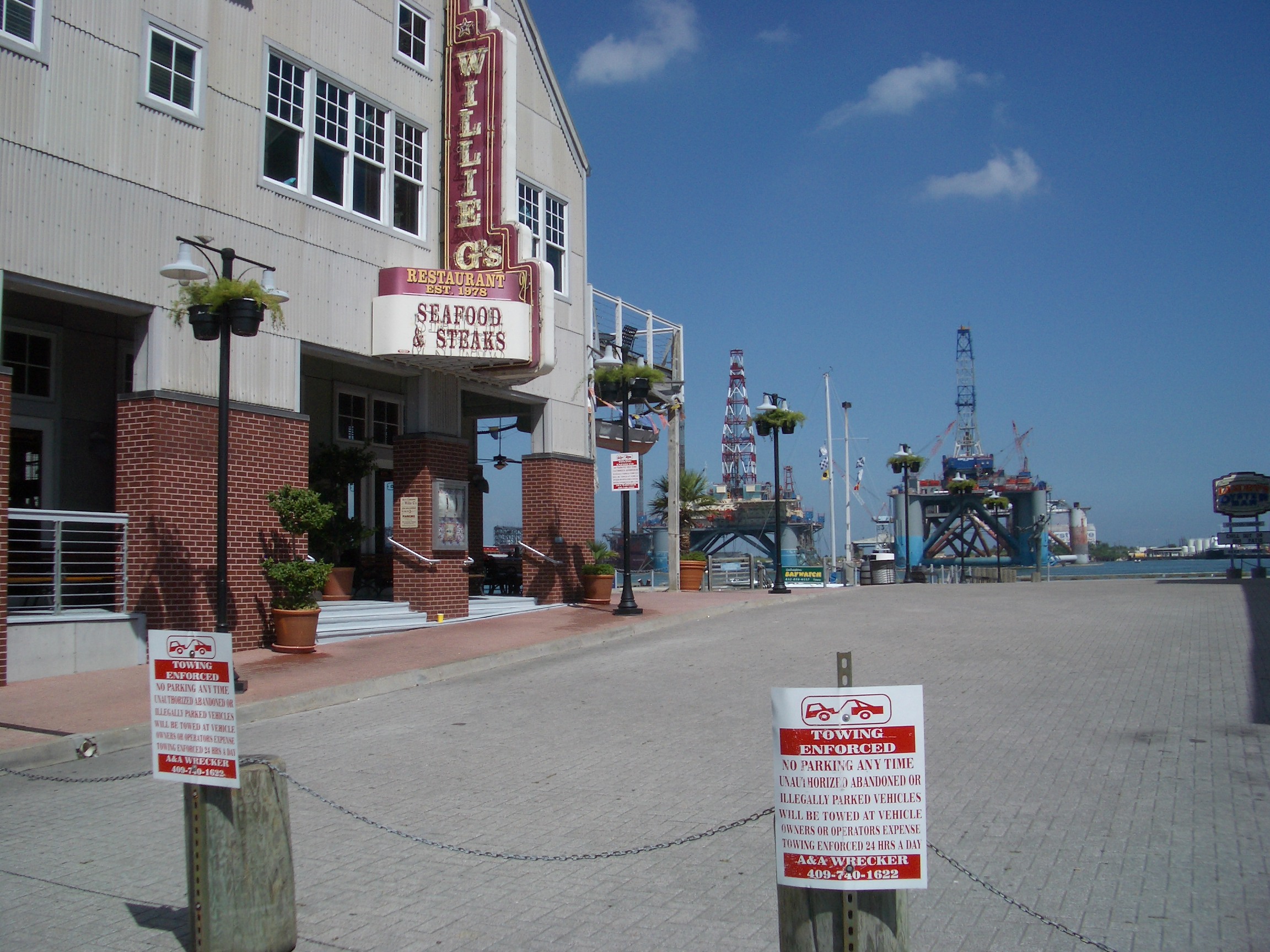
Isaac's Storm or Isaac's Hubris. The worst natural disaster in the United Stated still to date is the Hurricane of 1900
In terms of lives lost, the worst natural disaster in US history was the hurricane which struck Galveston, Texas without warning on Saturday, September 8, 1900, completely leveling the island's 18 city blocks and killing at least 8,000 people within a few hours' time.
In 1900, Galveston was a thriving and sophisticated seaport of 37,000 residents. Amassing great wealth as a hub of the cotton trade, Galveston was the first city in Texas with electricity and telephones and had 50 miles of streetcar track on an island only 3 miles in length. Boasting more millionaires than Newport, Rhode Island had at the time, the city was home to an Opera House and the consulates of 19 foreign nations.
But in an age before weather satellites and with little scientific understanding of meteorology, Galveston was woefully unprepared for the arrival of a major hurricane. The only way to get advanced warning of storms in those days was word-of-mouth spread from ship captain to ship captain and only then if somebody happened to stumble onto the storm in time. To make matters worse, many people thought Galveston was too far north to be hit by a major hurricane, so when rumors of a big storm were reported to the city's weather bureau on September 4, forecasters confidently decided that the storm would hit Florida.
The memoirs of Isaac Cline, senior Weather Bureau employee present at Galveston during the storm, illustrate the lack of understanding of how suddenly hurricanes can hit: "The usual signs which herald the approach of hurricanes were not present in this case. Showery weather commenced at 8:45 a.m. on September 8, 1900, but dense clouds and heavy rain were not in evidence."
Indeed when winds rose to an unusual 15 miles per hour on Friday evening, few if any were concerned, and as the winds steadily grew stronger on Saturday morning, unconcerned residents, rather than fleeing, flocked to the beach to gawk at the huge 15-foot waves. At some point in mid-morning, as the winds rose toward 50 miles an hour, a steamship broke lose from its moorings and crashed through the three bridges that connected Galveston to the mainland, cutting off any escape. The stage was set for disaster.
Around noon, the winds began to shift to the east, finally allowing the storm, which had previously been held at bay by the northerly winds, to smash into the city with its full force. The city began to flood, slowly at first, and then at an increasingly rapid rate, in a surge that would ultimately reach 15.7 feet above mean high tide.
Unfortunately, the highest point in the whole of Galveston island was only 8.7 feet above sea level.
As the flooding progressed, the trapped residents of Galveston headed to higher ground, huddling together in large groups on the last scraps of dry land like "rats clinging to the sinking mast of a ship" in the memories of one of the survivors. When even those areas flooded they began to climb trees and head upstairs to the second and third floors and finally to the roofs of the city's tallest buildings as houses and smaller buildings were swept away.
Winds reached at least 102 miles per hour before the city's sole anemometer was swept away, and modern estimates put them at 145 mph at the height of the storm, which would place the hurricane at category 4 out of a possible 5 on the modern Saffir/Simpson scale. The last barometric pressure recorded by the Galveston weather bureau was 28.55 inches, the lowest barometer reading that had ever been recorded by anyone anywhere up to that time.
In then end, even the highest buildings collapsed under the surge and residents either survived the storm by clinging to debris and riding out the wind, rain, and waves for nearly a full 24 hours, or they drowned. Even among those who survived, many were injured or permanently maimed by the scudding, swirling debris whipped to and fro across the surface of the sea by the winds.
Estimates of the death toll are necessarily imprecise given that many of the bodies were carried out to sea and never found, there was no account of the exact number of people living in and around Galveston, and with whole families wiped out, no tally of the missing could be carried out after the storm. What is known is that at least 6,000 people were killed on Galveston island, and another 2,000 when the storm carried on to smash into the towns edging Galveston Bay during the night of September 8-9. The upper estimates place the total death toll as high as 12,000 people.
Eventually, the storm would cross the entire continent, bringing 70 mile per hour winds as far north as the Great Lakes, and not completely burning itself out until it was somewhere over Siberia.
By mid-morning on September 9, the waters had receded and the island reappeared on the map. The scene of devastation that emerged bordered on the apocalyptic. Old photographs show massive beams of wood scattered and heaped about like some gargantuan child's abandoned lincoln logs. Survivors wandered about in a state of utter shock, many bloodied and nude, their cloths having been sucked off completely by the mighty winds. Thousands of bodies of people and animals lay scattered about, buried under the debris, or even hanging from trees to the point where the waters had risen, and as the humidity and heat began to rise an unbearable stench rose up over the city and would linger for months until the last bodies were exhumed from under the deepest debris.
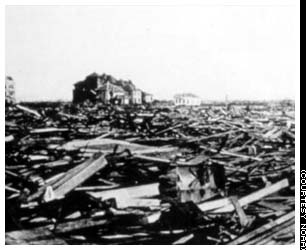
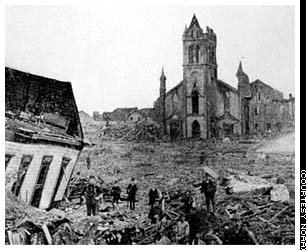
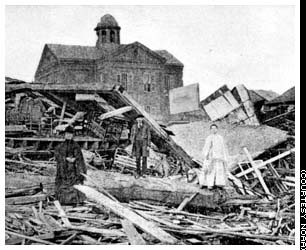
Disposal of the bodies soon became a major problem. On an island, there was simply nowhere to bury them. At first they were stacked on hastily constructed barges like cordwood and floated out to sea, but in a macabre twist the tide simply carried them back, depositing them in heaps on the shore. At last the city's temporary leaders ordered mass burnings of the dead, who were collected by exhausted "dead gangs," who were plied with whiskey and even threatened at gunpoint to keep them working. The corpses were piled on massive funeral pyres which were kept burning non-stop for more than a month, only adding to the stench.
Another problem was looting and lawlessness, as some of the trapped residents of the islands took advantage of the complete collapse of civic and social order to commit all manner of crimes. Martial law was declared, and vigilante groups prowled the streets, executing on the spot at least 125 people who they decided were attempting to loot property, rob the dead, or lay a hand on a woman.
One aspect of the tragedy which drew particular attention was the extinction of nearly every resident of Galveston's St. Mary's Orphanage which collapsed during the storm - 90 out of 93 orphans and all 10 nuns perished. Days after the storm, one of the children was found on the beach near where the orphanage once stood. When the toddler's body was lifted, another child and another and another emerged from the sand. Altogether, 8 children and a nun had tied themselves together with clothesline in an attempt to ride out the storm. Another story tells of a child who survived because someone had nailed his wrist to the orphanage's rooftop.
Ultimately, the city of Galveston did recover. Learning from their past complacence, they constructed a mammoth seawall, 17 feet high and three miles wide, and drastically raised the island's elevation by means of a massive dredging of Galveston Bay. When another major hurricane struck Galveston on August 16, 1915, only eight people were killed, a testament to lessons well learned.
After watching a documentary on the 1900 Hurricane, the boys were massively under-whelmed in the Museum, which was nothing more than a Book and Trinket Shop, where Bone did buy a souvenir Hurricane cup for his Weather-Obsessed better-half, Jenny.
The Strand, the oldest part of Galveston that was not destroyed by the Hurricane
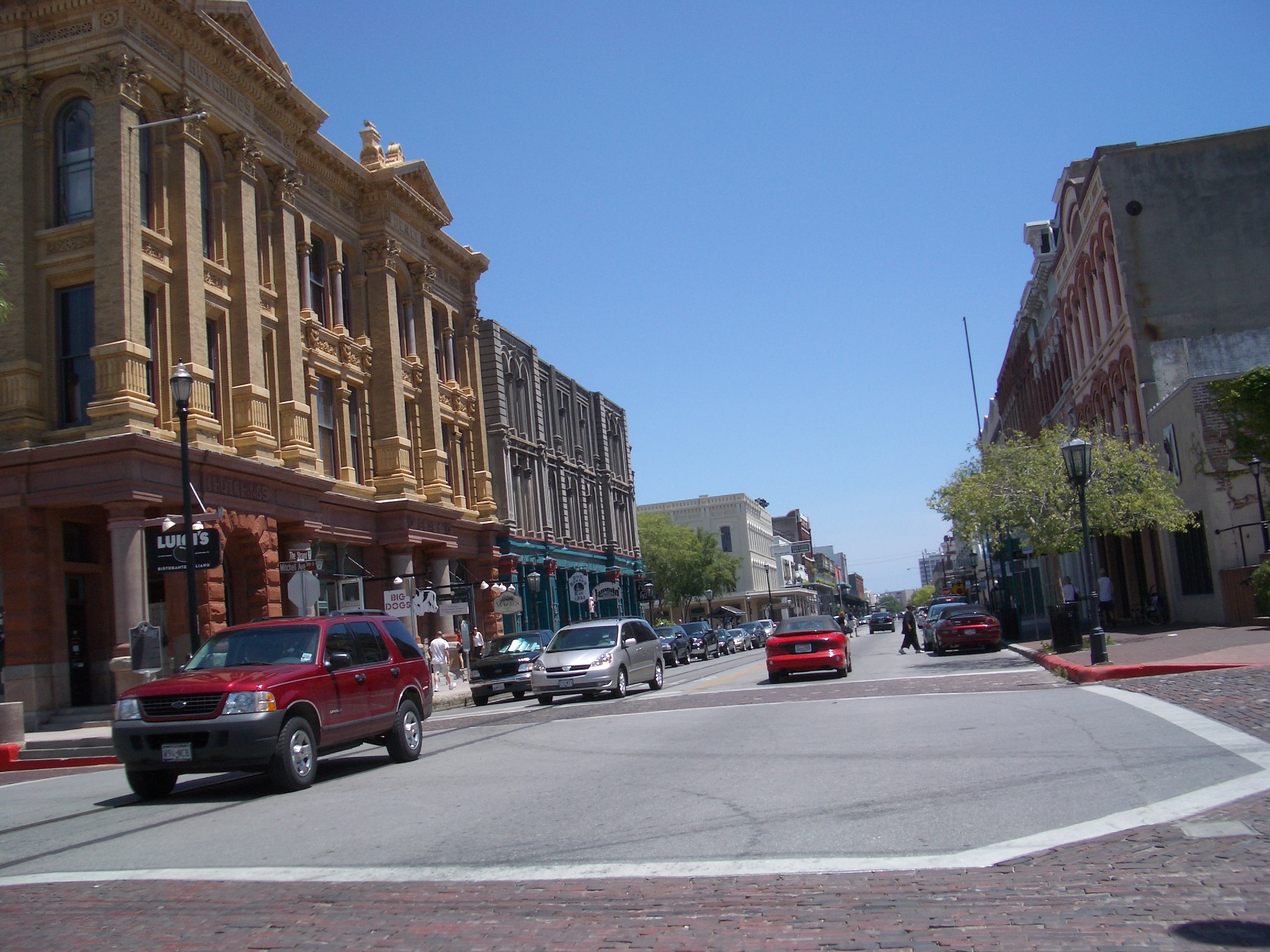
"Gee Mister it is only 3 hours" When the Boys booked the trip they had flown into Houston and were intending in flying out of New Orleans, with the goal of meandering along the Gulf Coast, checking out the Cajun Culture along the Texas/Louisiana coastline. Before embarking on the trip to the Big Easy, Mike and Bone checked with an innocent and soon-to-be-found-out vacant teenager on how long it would take to drive to N'Awlins, she stated "no more than three hours". With it being noon the boys had high hope of hitting some sites in the Crescent City.
Mike and Bone on the Ferry back toward Port Arthur

Rather than taking the very crowded I-45 back to Houston and on to I-10, the Boys took the Ferry that circumvented at least 1-2 hours of back-tracking through Houston, which didn't only save time, traffic, and hassle, it was way cooler
"May I have some Peanut Butter with those Jellyfish"
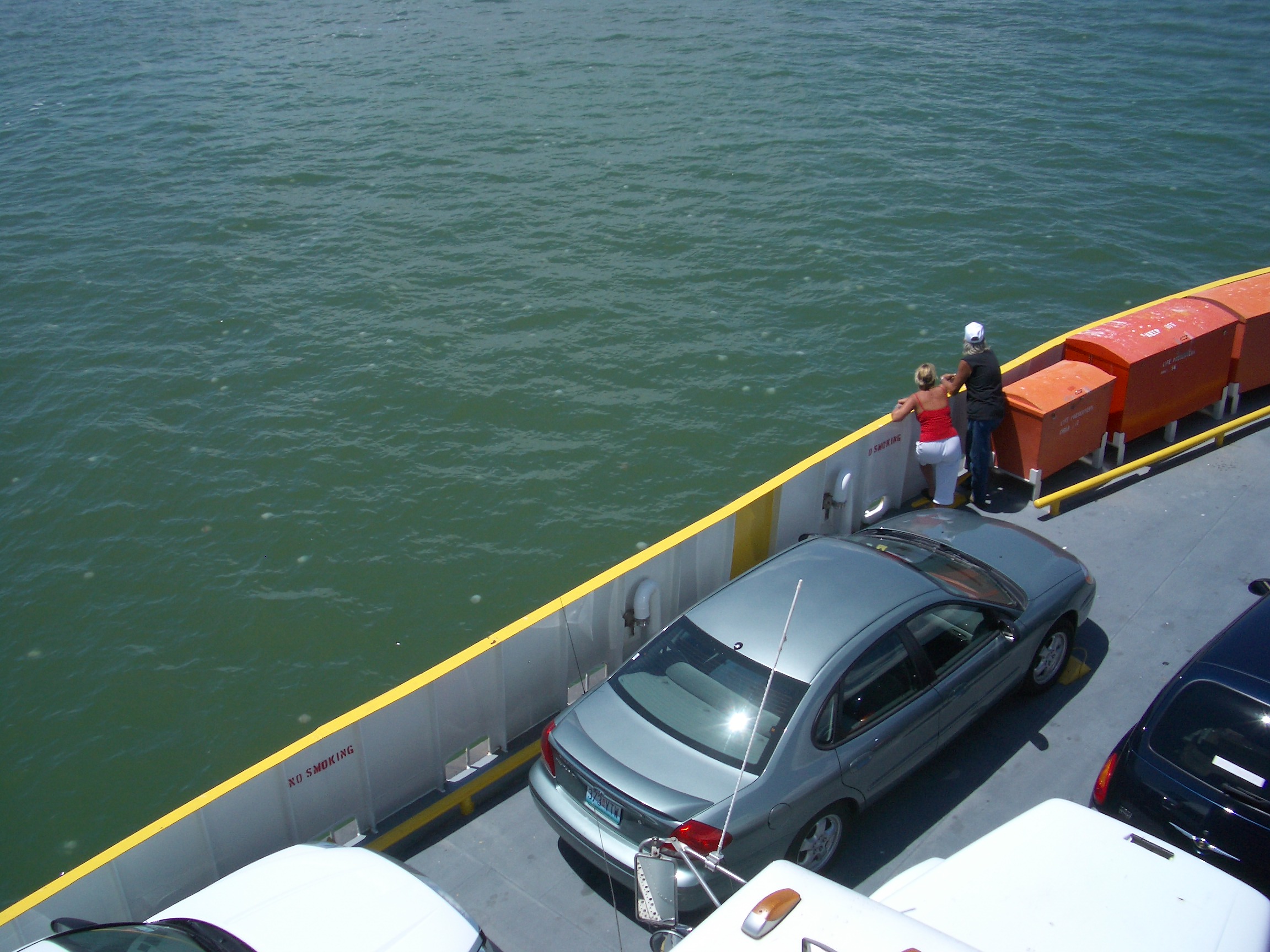
The Ferry ride definitely gave the boys a good view of the Gulf into the Houston Shipping Channel and the surrounding terrain, none of which was terribly attractive. It was very industrial and dirty. The waters were always a mucky brown and often littered with mile after mile with jellyfish. Fortunately the very well stocked Hall of Shame, provided sustenance to the Boys on the 45-minute ferry ride which landed them within an hour of the Louisiana Border
Mike and Bone Meandering East long the Texas Coastline
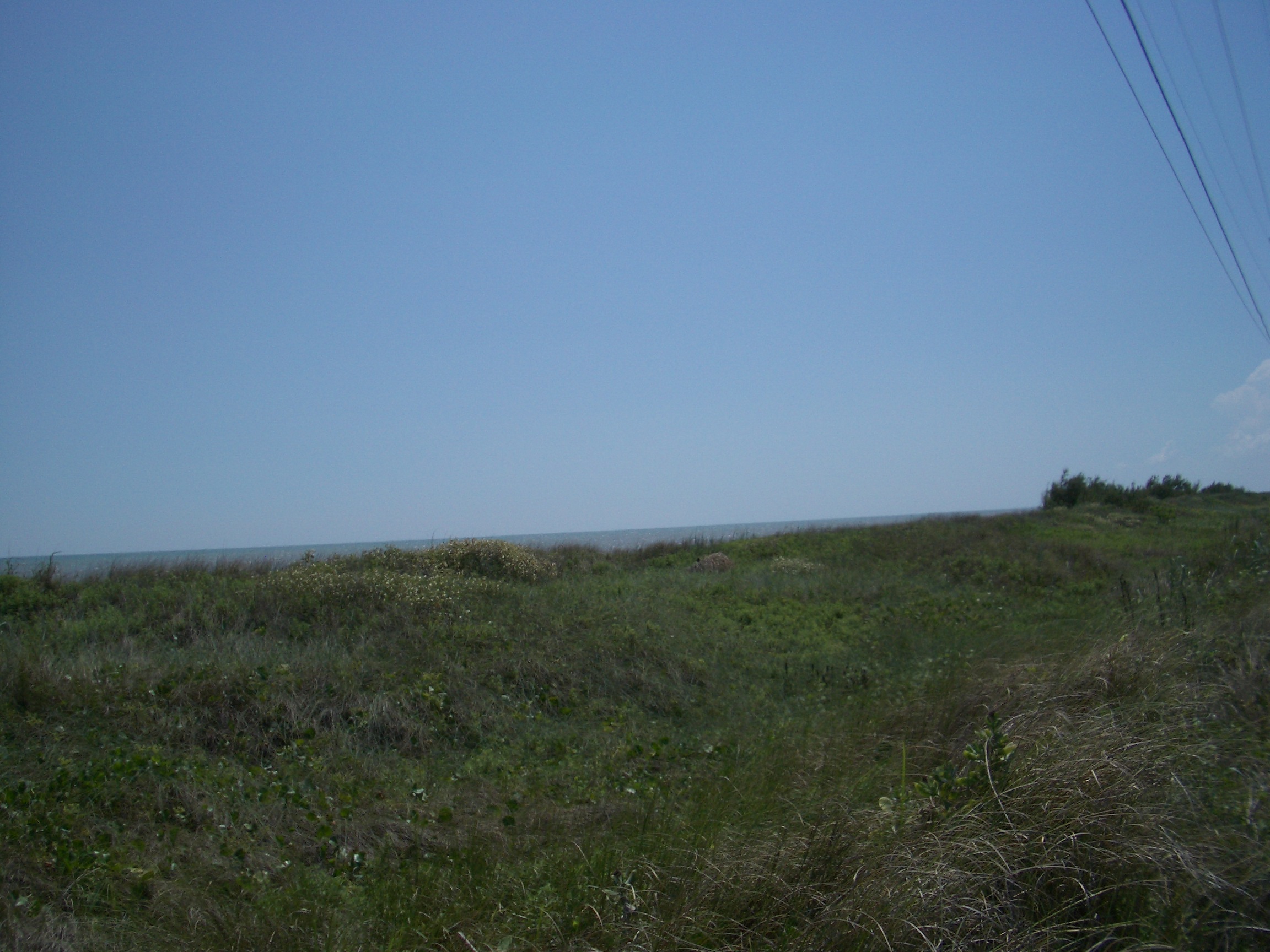

Houston and the industrial waste soon vanished, as the Boys continued East through resort towns and salt marshes, while enjoying cooler Gulf breezes and colder beer, the boys were finally able to roll down their windows and take in the salt air off of the Gulf of Mexico. As the brewski provisions rapidly depleted, the boys stopped bought some local fried chicken, and Corona (clearly the beverage of hot weather !)
Welcome to Louisiana, Home to Stinky Oil Rigs
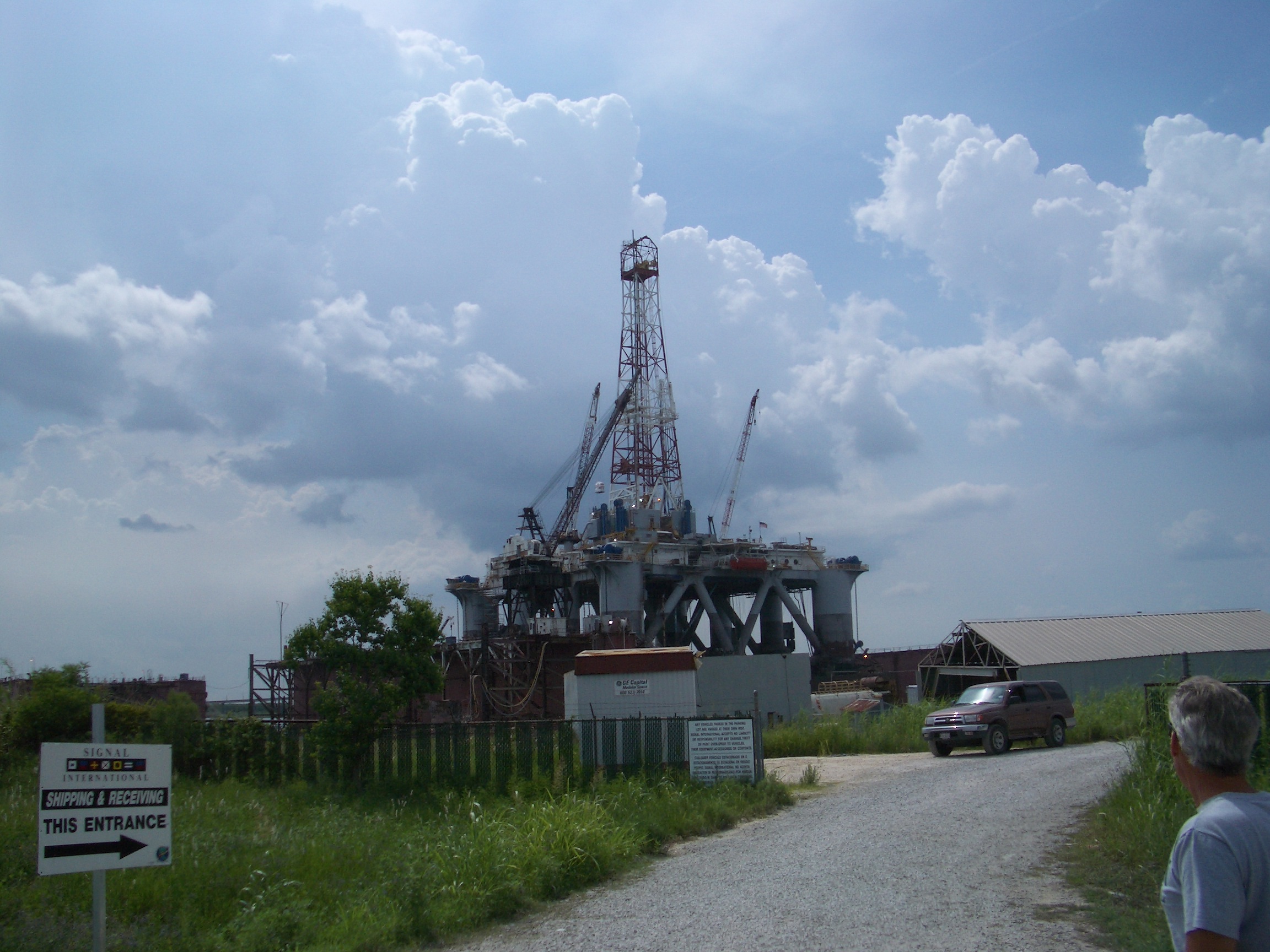
Soon the boys found themselves passing through Port Arthur Texas and into Louisiana the home of the Cajuns, Creoles, and Oil Rigs, where along with the lovely heat and humidity, they could the enjoy the fetid smells of chemicals.
"You all gotta be kidding me !!
Despite idyllic thoughts of ramblin' through the bayous and Gulf Coast, most of the road along the coast took the boys through squalid little towns and dirty coast line, after several more hours of driving, while gassing up they asked how far from New Orleans were they. The old Cajun lady ( we are being polite here !) drawled incoherently "You-all at least 6-7 hours away. Frantic and pissed the boys asked was any faster way back. Sadly taking the interstate would only shave 2 hours off of the trip, and being it was already pushing 6:00, having any fun-time in N'Awlins was becoming less likely.
The Boys also considered returning to Galveston and choking the naive teenager to death,,,, not out of hate and anger ,,,,,, but by a desire to not see her DNA propagate in our gene pool.
The bayous of Louisiana

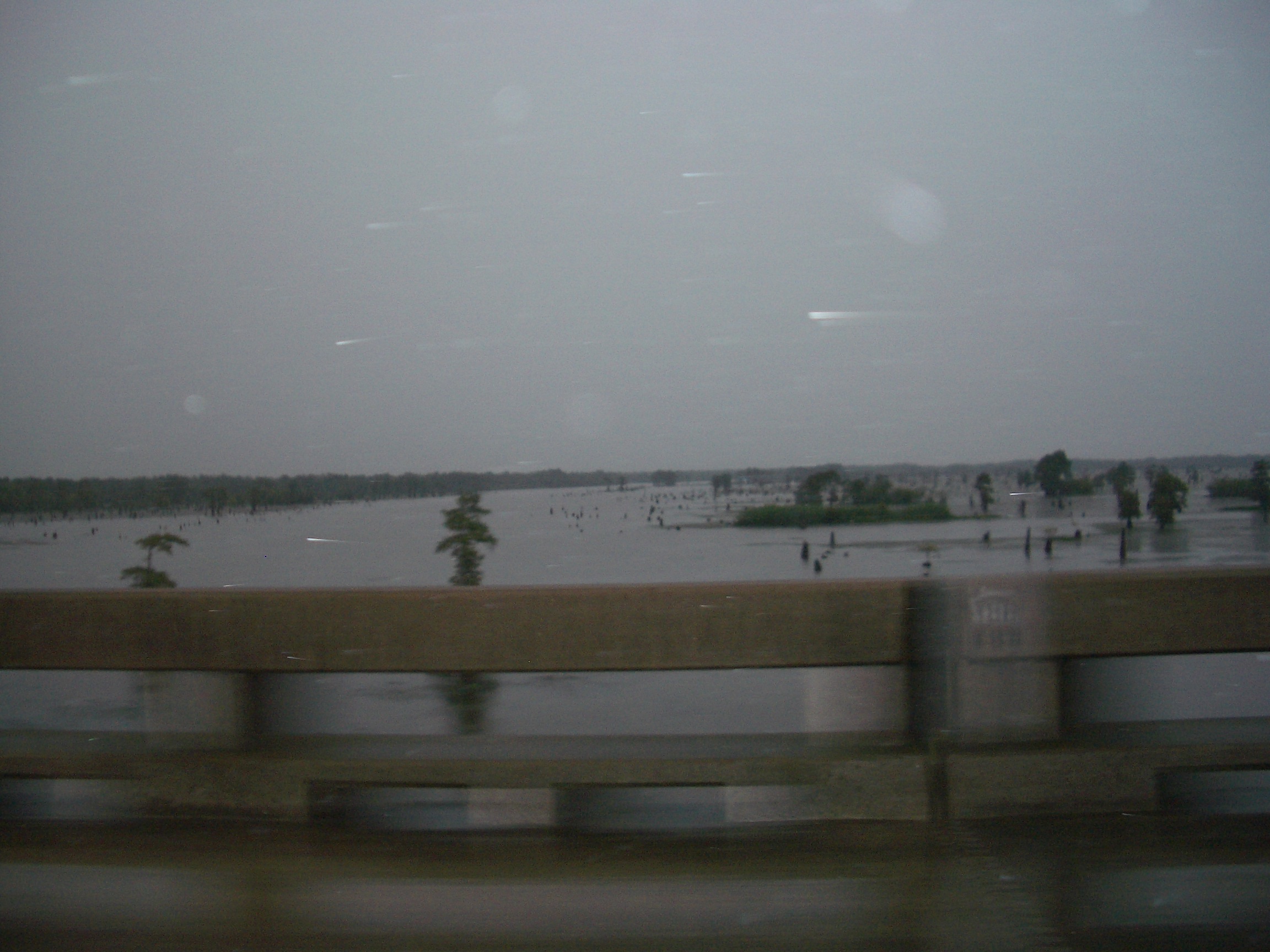
After the bad news and the gas, the Boys shifted into warp drive and double-timed it east through the Bayous and south through Baton Rouge into the Crescent City through torrential rain storms in record time. Unfortunately it was pushing 11:00 PM, fortunately it was New Orleans !! Where the night never ends !
Scarfing Crawfish Etoufee at Arnauds @ Midnight

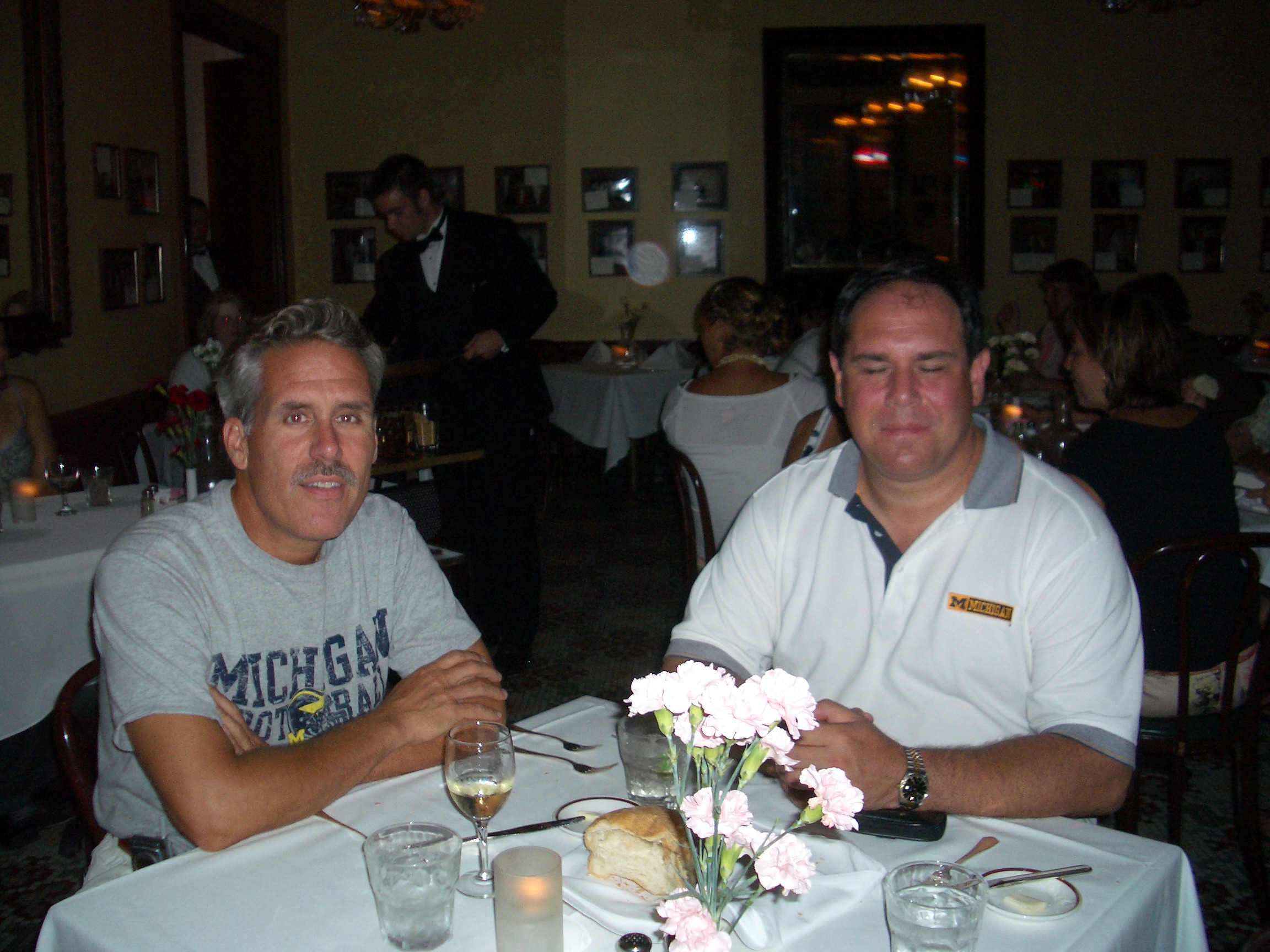
Checking into the Marriott on Canal Street (a scant two blocks from Bourbon Street and the French Quarter) the boys dumped their stuff and with help from the concierge, were able to go to one of the premier Restaurants in the French Quarter, the Historic Arnauds Restaurant, where while the boys chowed on their gumbo's and etoufees, they were serenaded with some gen-u-wine French Creole Jazz.
Flaming Fountains, Slurping Hurricanes at Pat O'Brien's in the French Quarter !!!
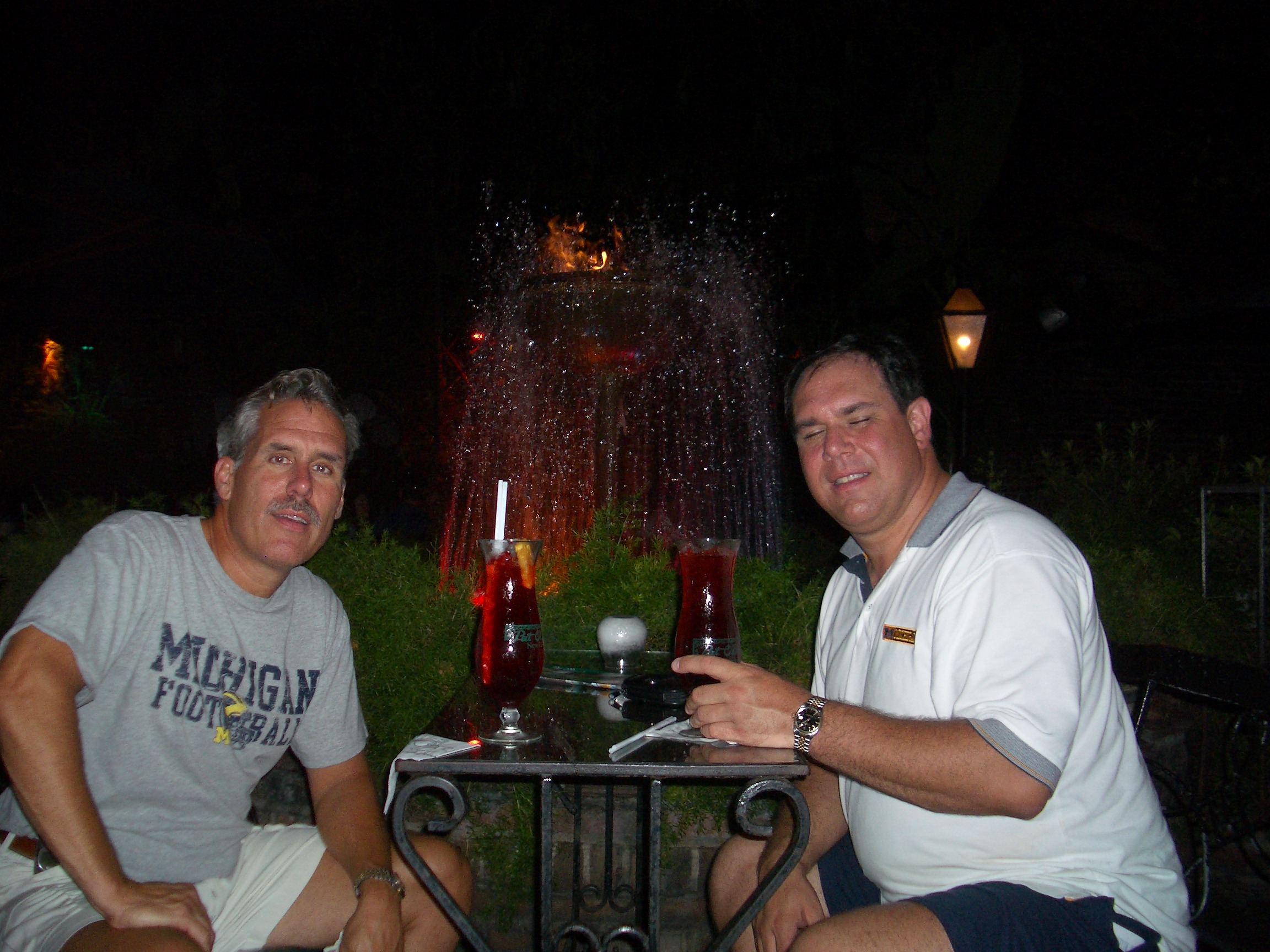
Stated with a great meal, Mike and Bone descended into the one place that can handle the tomfoolery that are Mike and Bone,,,,,,, Bourbon Street !!!
You can't really say that you have done Bourbon Street, the French Quarter, or even N'Awlins, until you'll have had a Hurricane next to the flaming fountain at Pat O' Briens. Hurricanes, the Piano Bar, the Flaming Fountain, and green-jacketed waiters are what have given the 67 year old world-famous Pat O'Brien's the motto of "Have Fun!"
During the days of Prohibition in the 1930s, B. H. "Pat" O'Brien operated "Mr. O'Brien's Club Tipperary," one of many speakeasies in New Orleans, whose doors opened only to the select few who knew the passwords, "Storm's Brewin." When the Prohibition Amendment was repealed in 1933, Mr. O'Brien moved his now legal drinking establishment across the street from the speakeasy to Pat O'Brien's original location in the 600 block of St. Peter.
Once the Bar's name was established as the place to be, a much larger facility was needed. The present site of Pat O'Brien's now at 718 St. Peter Street was built in 1791. This location originally housed the country's first Spanish Theater, then later became the private residence of the Deflechie Family. Pat O'Brien purchased the building in 1942 and moved his establishment. Under the management of Pat O'Brien, Charlie Cantrell, and George Oechsner, Jr., the bar with the modest green-and-white sign began to flourish.
Not wanting to be excluded for the boys imbibed the magic elixir of Hurricanes to the point of inebriation. Not wanting to hurl and 2:30 in the morning, they decided to wander the still crowded streets.
in the spirit of Ignatius C. Reilly, the "Original Confederacy of Dunces", Mike and Bone on Bourbon Street !!!
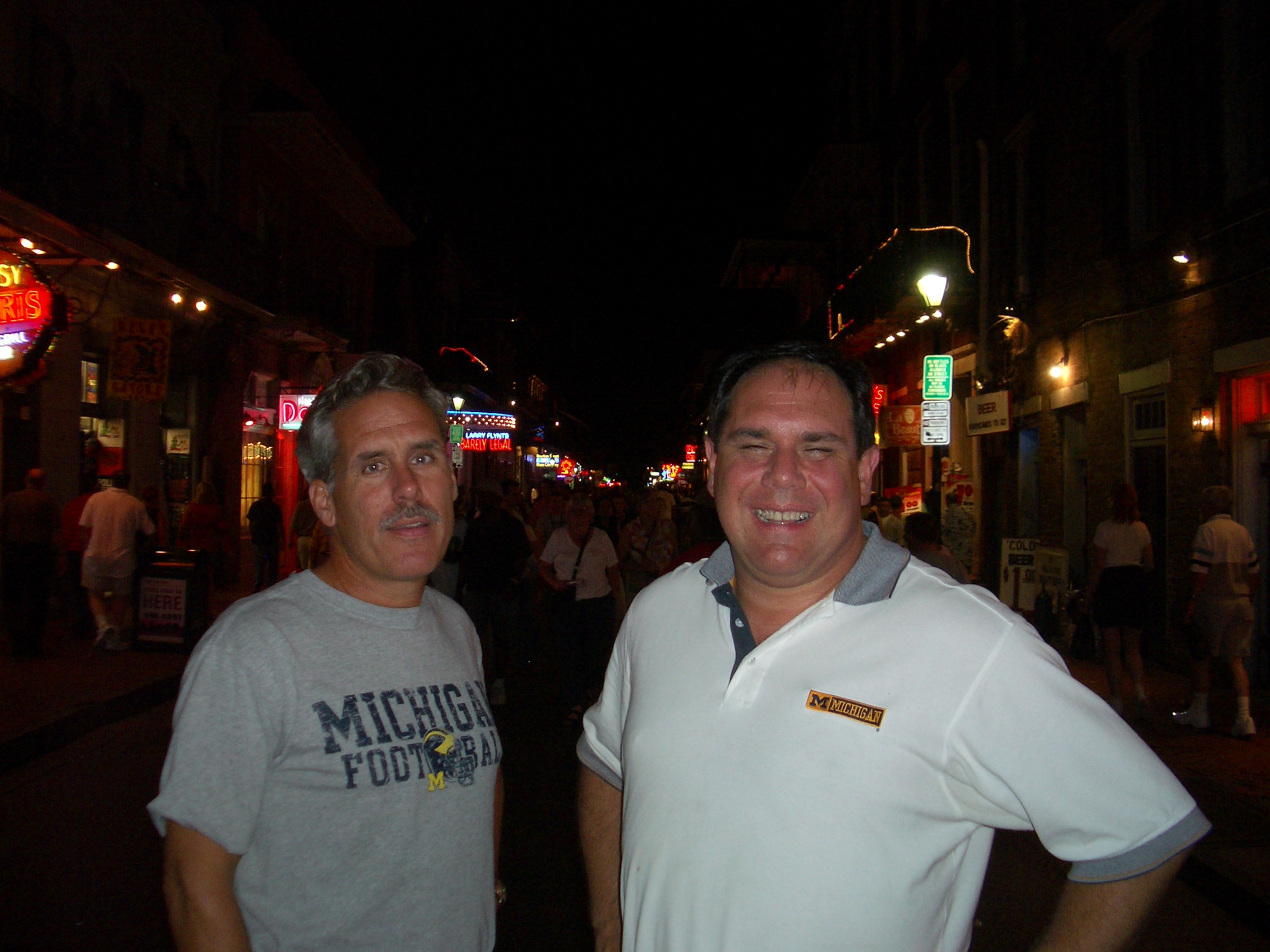
Thanks for the Mamories !!!. You really gotta love Bourbon street and cheap, plastic beads. "Say What?!?! you say ? Only in New Orleans will normal, preppy, stuffy, suburbanite white women will drop their tops for the simple bauble of plastic. As the boys in the still crowded streets through the beads to the babes for the bra-less bounces of fate, Mike and Bone oogled on with intense middle-aged interest. Yep, you really gotta love N'Awlins !!!
"You Sir are a Lucky Dog !!
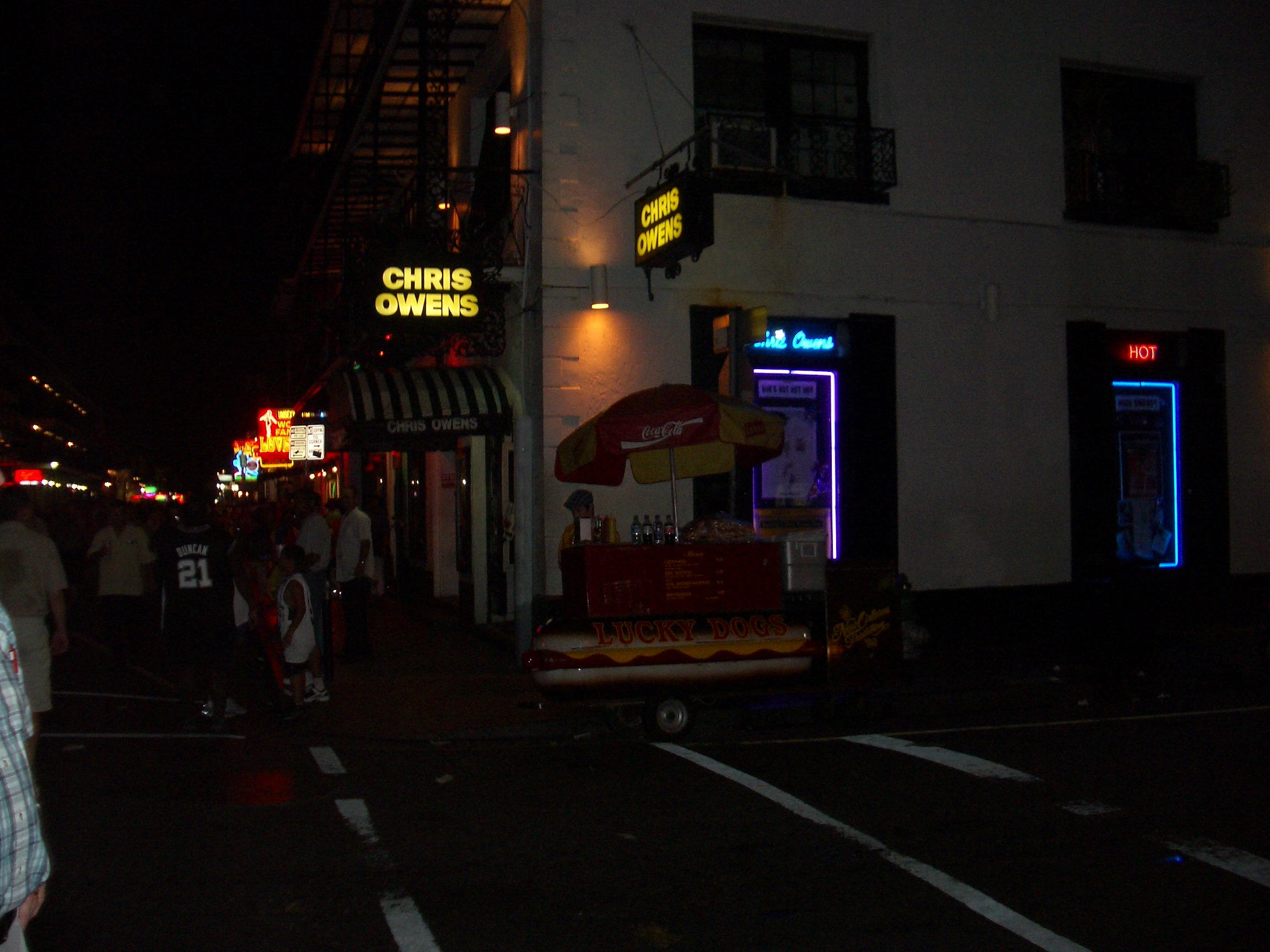
After the great meal, music, booze, and bra-lessness, the boys staggered by another Crescent City staple Lucky dogs, so after an expensive and awesome meal at Arnauds, the boys staggered back to Canal Street chewing on questionable hot dogs. Only Mike and Bone would start a day in Galveston and finish one 20 hours later in the Big Easy.
It was also VERY easy for the Boys to close their eyes at 4:00 AM !!!